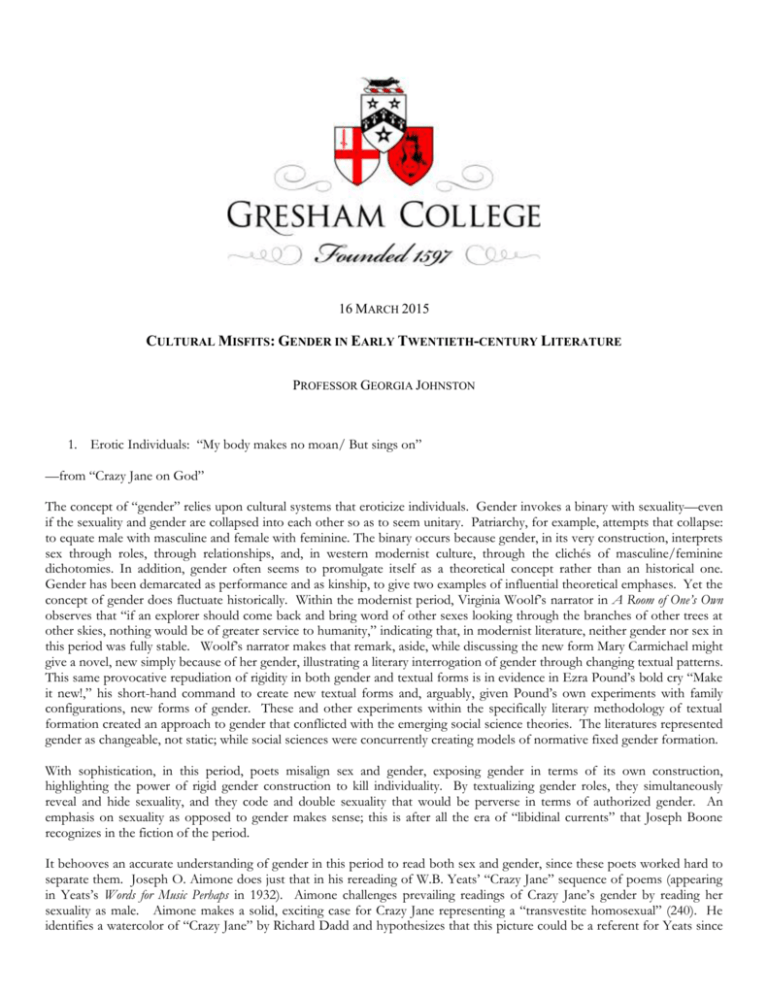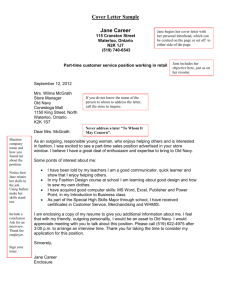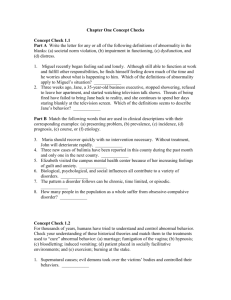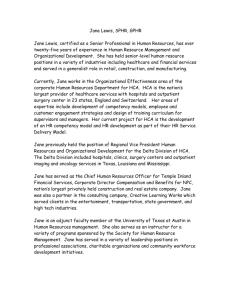
16 MARCH 2015
CULTURAL MISFITS: GENDER IN EARLY TWENTIETH-CENTURY LITERATURE
PROFESSOR GEORGIA JOHNSTON
1. Erotic Individuals: “My body makes no moan/ But sings on”
—from “Crazy Jane on God”
The concept of “gender” relies upon cultural systems that eroticize individuals. Gender invokes a binary with sexuality—even
if the sexuality and gender are collapsed into each other so as to seem unitary. Patriarchy, for example, attempts that collapse:
to equate male with masculine and female with feminine. The binary occurs because gender, in its very construction, interprets
sex through roles, through relationships, and, in western modernist culture, through the clichés of masculine/feminine
dichotomies. In addition, gender often seems to promulgate itself as a theoretical concept rather than an historical one.
Gender has been demarcated as performance and as kinship, to give two examples of influential theoretical emphases. Yet the
concept of gender does fluctuate historically. Within the modernist period, Virginia Woolf’s narrator in A Room of One’s Own
observes that “if an explorer should come back and bring word of other sexes looking through the branches of other trees at
other skies, nothing would be of greater service to humanity,” indicating that, in modernist literature, neither gender nor sex in
this period was fully stable. Woolf’s narrator makes that remark, aside, while discussing the new form Mary Carmichael might
give a novel, new simply because of her gender, illustrating a literary interrogation of gender through changing textual patterns.
This same provocative repudiation of rigidity in both gender and textual forms is in evidence in Ezra Pound’s bold cry “Make
it new!,” his short-hand command to create new textual forms and, arguably, given Pound’s own experiments with family
configurations, new forms of gender. These and other experiments within the specifically literary methodology of textual
formation created an approach to gender that conflicted with the emerging social science theories. The literatures represented
gender as changeable, not static; while social sciences were concurrently creating models of normative fixed gender formation.
With sophistication, in this period, poets misalign sex and gender, exposing gender in terms of its own construction,
highlighting the power of rigid gender construction to kill individuality. By textualizing gender roles, they simultaneously
reveal and hide sexuality, and they code and double sexuality that would be perverse in terms of authorized gender. An
emphasis on sexuality as opposed to gender makes sense; this is after all the era of “libidinal currents” that Joseph Boone
recognizes in the fiction of the period.
It behooves an accurate understanding of gender in this period to read both sex and gender, since these poets worked hard to
separate them. Joseph O. Aimone does just that in his rereading of W.B. Yeats’ “Crazy Jane” sequence of poems (appearing
in Yeats’s Words for Music Perhaps in 1932). Aimone challenges prevailing readings of Crazy Jane’s gender by reading her
sexuality as male. Aimone makes a solid, exciting case for Crazy Jane representing a “transvestite homosexual” (240). He
identifies a watercolor of “Crazy Jane” by Richard Dadd and hypothesizes that this picture could be a referent for Yeats since
2
it was exhibited in London in 1913, noting that “a close look at the painting [will] unsettle any conviction that the figure
represented is simply a female” (237). Quoting sections from the poems that give him a case for this reading of Crazy Jane as
a transvestite, he notes Crazy Jane’s lines “A woman can be proud and stiff” and “Love has pitched his mansion in/ The place
of excrement” (237). Because of his readings of the male sexuality of the figure, which produces a transvestite gender rather
than a woman’s gender of Crazy Jane, Aimone argues that Yeats’s own masculinity is complicated; he suggests two types of
masculinity appear in Yeats’s oeuvre: a “repressed masculinity” where Crazy Jane’s “homosexuality reflects the repressive” as
well as an “early, sensuous, and decadent masculinity.” Aimone’s reading emphasizes the difficulties of reading
sexuality/gender identifications. As Aimone concludes, “Jane passes” as a woman (244).
Aimone’s arresting reading signals the sexual duplicity represented in this era of radical changes in roles, relationships, and
cultural expectations. His reading makes clear the difficulties of reading gender in modernist poetry, since the normalizing
effects of gender make difficult a realization of sex outside gender’s historical conception.1 At least in this series of poems,
sexuality would seem to be a matter of barely visible reference for Aimone, multiply elusive because, all the while, his reading
coexists with an equally complicated reading of Crazy Jane based on her gender as a woman. Equally valid is Elizabeth Butler
Cullingsford’s reading of Crazy Jane as “an erotic and licentious female figure” (227). Reading Jane as a woman emphasizes
gender, rather than sexuality, since Crazy Jane and the Bishop struggle about normative sexuality and desire, a struggle in
which Crazy Jane, a woman unapologetic about her sexuality, states that “‘Love is all/ Unsatisfied/ That cannot take the
whole/ Body and soul’” (“Crazy Jane on the Day of Judgment”). The two positions revolve around women’s gender in terms
of unacceptable and acceptable attitudes towards her body. The Bishop, urging Crazy Jane to move from the body to the
“heavenly mansion,” reminds her of her age, that “‘Those breasts are flat and fallen now,/ those veins must soon be dry”
(“Crazy Jane Talks with the Bishop”). Crazy Jane, in contrast, places her sexual desires and sexual acts in nature: she and Jack
meet under “the oak, for he/ [. . .] Wanders out into the night/ and there is shelter under it” (“Crazy Jane and the Bishop”); in
another poem, she is “‘Naked” with “The grass my bed” (“Crazy Jane on the Day of Judgment”). By placing the body in
nature, she infers that the sexual acts are natural ones, not (as the Bishop would label them) perverse. This reading of the
forceful contrast of societal positions on gender is as potent in these poems as is Aimone’s reading of elusive and revelatory
sex. Aimone’s argument reveals that reading sex and gender in modernist poetry must identify palimpsestic layers, which might
be so conflicting as to seem to cancel each other.
On the surface these poems relate an anxiety surrounding individual sexuality, which would be subverted when pressed into
conformity by institutionalized culture. The Bishop’s moralizing shaming works as a metaphor for the regimentation that any
woman (or transvestite homosexual) could expect to endure at the hands of modernist cultural hierarchy. While the Bishop
tries to insert normative definitions of women’s sex/gender roles, Crazy Jane defends her body, stating that her “body makes
no moan/ But sings on” (“Crazy Jane on God”). Repudiating conformity, Crazy Jane is a misfit, a social outcast, longing for
“Jack the Journeyman,” her lover, also an outcast.
These tensions between individual sexuality and social gender, and the duplicitous invisibility of sex, can be identified in more
modernist poetry than the “Crazy Jane” series, which I will show through poetic use of death, mythic iteration, and linguistic
repetition. My analysis will show that the tensions appears in so much of the poetry that it can be identified as a specifically
modernist poetic marker of an early-twentieth-century cultural struggle—a struggle between the poets and the social sciences,
whose models defined normative genders out of varying individual sexes and varying sexual actions. Through their
documentation of “abnormal,” the social sciences of this time reinscribed an expectation of individual regulation within a
collective scheme. Cristanne Miller makes the point that “there was increasing pressure for stricter normative and more
sexually focused categorization” in the early part of the century (68). Social scientists narrated heterosexual sexuality and
gender as normative, even while these social sciences recognized (and—to identify the abnormal—relied upon) individual
variations to the normative gender constructions. Internationally famous social science theorists of the period (all with various
links to study of sexuality and gender)—Freud, Otto Weininger, Havelock Ellis, Francis Galton, and Lombroso—each
classified and typed. In this way, they were able to identify, define, and essentialize (unattainable) heterosexual gender
1
Neil Bartlett’s study of gay activity in London and its silencing is indicative of the difficulties in reading what has been made
invisible. Bartlett tries to document gay culture in London in the twenty years between 1875 and 1895, and he suggests that “the
active denial of the existence of [gay] culture in London [. . .] from Fanny and Stella to Bosie and Oscar, can be traced in the form of a
heavy silence. All through these twenty years there was an intense scrutiny of the “underworld” of London” (143). Rather than
observing gender politics that are aligned with normative genders, critics like Aimone and Bartlett focus on analyzing the process of
the poetries and cultural acts that represent unrecognizable ones.
normativity of the individual, whether for psychoanalysis, sexology, eugenics, or criminology.2 Taxonomies of normality and
medicalized difference produced (and reinvigorated) expectations of normative heterosexual sex/gender.
In the “Crazy Jane” series of poems, Yeats sets up on surface the normative gendered categories of early 20th century western
culture through his Bishop, and also defies them through Crazy Jane. The Bishop tries to force a normative feminine gender
model on Crazy Jane, which reflects the social science reification of sex/gender societal expectations. By defining sex and
classifying gender, social sciences (and the Bishop) emphasize an authoritative collective, to which an individual should
conform.
Crazy Jane, of course, does not.
Modernist poetry amplifies these tensions between individual and collective, opposing social sciences. The foregrounded
tension marks a particularly literary paradigm in this historical period. The poetry magnifies the tension by creating
deliberately unstable textual formations. Throughout the “Crazy Jane” series of poems, for example, refrains interrupt a ballad
formation. A refrain is an old type of textual formation, but when the refrain interrupts the stanzas, as in “Crazy Jane and the
Bishop,” it satirizes the idea of unity and established meaning. There, the (italicized) refrain “All find safety in the tomb” occurs
in each stanza and interrupts the sequence of lines that follow each other syntactically. This stanza—
Bring me to the blasted oak
That I, midnight upon the stroke,
All find safety in the tomb,
May call down curses on his head —
begins the poem, with the refrain interrupting the wish of the speaker to “call down curses.” The refrain is equally interruptive
in each stanza, and it destabilizes the concept of linear meaning.
Many cases of textual innovation intersecting with gender reinforce the point that a textual formation underscores the poetic
concerns about tensions between gender and individual expression. Two examples already identified by critics come to mind.
First, Susan Stanford Friedman notes that, by reforming the epic, H.D. “feminized epic convention” (203). Second, David
Ayers reads Nancy Cunard’s Parallax as “a new rhetorical form”, emerging from “Cunard’s reading of Eliot in terms of
herself” (Modernism 32). He describes the poem as “a quoted voice within a quoted work” (34), and interprets Cunard as
creating a “hybrid third person,” with characteristics of both male and female.
In poetry by T.S. Eliot, H.D., Stevie Smith, Wilfred Owen, and Gertrude Stein, sex, gender, individual, collective, and textual
formation coalesce to make visible the fluctuation in gender prominent in the modernist period.
2. Killing the Individual: “not waving but drowning”
By representing the messiness of human life that cannot fit systemic expectations, modernist poets trouble a seemingly
incontestable social science sublimation of an individual into a collective. Rather than mirroring social science understandings
of gender, T.S. Eliot, Wilfred Owen, Stevie Smith, and H.D focus on individual exclusion from and rejection of institutional
systems that prescribe gender in models and behavior. They present misfits outside the culture. For example, Eliot’s famous
1917 character Alfred J. Prufrock fails in culturally masculine roles. But which is perverse, the man or the culture that enforces
the model? The culture abases Prufrock, providing him with roles such as the Fool, rather than the acceptably masculine
Prince Hamlet; or with dead figures for his models—such as Lazarus and John the Baptist, hardly attractive or desirable. He
enters dream-like myth, which would allow him to fit gendered roles if he could interact with the myth as one might expect.
In that dream-land, he “heard the mermaids singing, each to each.” Nevertheless, even in myth, he does not fit; he does “not
think that they will sing to me.” He “lingered […] / By sea girls” rather than with the “women [who] come and go/ Talking
of Michelangelo,” yet he cannot remain in his dream. He “drown[s]” in response to the collective “human voices” who
“wake” him.
For “Prufrock,” women who conform to gendered parameters of “braceleted arms” and “head against the pillow” draw his
2
For an example of this method working itself out, see Cristianne Miller (particularly page 70), who gives a good overview of the
binary divisions between feminine and masculine incorporated into Weininger’s theories.
4
desire, but deny him, saying “that is not what I meant at all, no, not what I meant at all.” They parallel the sirens of the
mermaids, who call to him, arousing his desire, waking him, only to “drown” him. That language, that song—a mythic one, a
patriarchal one—places the woman as the object of desire, which patriarchy has prefigured as entrapping, snaring, and killing.
The man, to adhere to the expected masculine relationship with the women of the culture, must enter into that society and be
“drowned.” Of course this presentation of women is misogynistic, as Cristanne Miller points out that much of the men's
poetry is of this period, but it also places the perversion on the gendered models representing culture, not on the individual.
In other words, the nonconforming individual is the oppressed figure, so much so that he is killed by the collective "human
voices," because of a rigid formulation of gender, and it is the collective at fault.
The inability to fit into a collective shatters an alignment of sexuality and gender. The self dies when confronted with societal
expectations of conformity. The individual does not match the collective. Strikingly, Eliot, Stevie Smith, and Wilfred Owens
all use the metaphor of drowning to represent death caused by patriarchal gender expectations. Owens’ use of drowning is the
most realistic, in that the man he describes in “Dulce Et Decorum Est” is actually drowning from the reactions in his lungs to
the gas in a World War I battle. The death also recurs in the narrator’s dream, where “before my helpless sight,/ He plunges
at me, guttering, choking, drowning.” Owen’s gassed man “drown[s],” and, in response, the fellow soldier narrating the poem
scourges patriotic masculinity in the last (broken) lines—“The old Lie: Dulce et decorum est/ Pro patria mori.” That literal,
realistic death by drowning from gas represents the death from allying oneself with the patriarchal myth that it is glorious to
die for one’s country. This repudiation of authority emerges, Lorrie Goldensohn suggests, from a "memory of fellow soldiers
as helpless sacrificial victims" which results in "looking at the higher leadership with hostility and suspicion" (18). The tension
between individual soldier and a cultural authority developed in the poetry to an erotic pitch, where "fraternity" (Goldensohn
18, 49, 53) becomes "a libidinal battlefield energy deflected from heterosexuality and redirected towards a split of emotions
that supports murderous ferocity towards one set of fellows [the commanding officers] and an expense of protective
tenderness towards another" (47). Certainly, Owen's poetry "remains impacted by conventional notions of manliness," as
Kathy J. Phillips points out, but these notions are not the conforming gender identifications with group systemic values.
Rather, Sarah Cole posits, they are of "an elevated nature, thereby casting out a protected sphere for the beloved body" (161).
Owens rejects the gendered masculinity of the war-mongers, when he repudiates conventional developmental models of
masculinity in favor of the “fraternal” (Goldensohn), going farther than the fraternal to produce "homoerotic fantasising"
(Corcoran 90). Neil Corcoran, on Wilfred Owen's "homoerotic fantasising" clarifies the range of Owen’s erotic positioning,
exposing once again how modernist poetry positions erotic body to oppose theories of gender, here conflations of masculinity
with patriotism. Owen realigns gender by opposing war and systemic institutions with the personalized erotic. The sexual
erotic expression takes precedence over a gendered one. Owen uses sexual eroticism against institutional forces of
conformity.
Stevie Smith also uses the metaphor of drowning to describe the exiled individual who does not fit. In “Not Waving but
Drowning,” she presents a “dead man” who is both alive and dead, as he “lay moaning.” The societal figures of the poem
misread the man, as a “chap” who “always loved larking,” since they think he was out in the water “waving.” The dead man,
in agony, calls “no no no,” repeating that he was “not waving but drowning.” As in “The Love Song of J. Alfred Prufrock,”
“Not Waving but Drowning” insists on a divide between those in society who are able to conform and be in a group (“They”)
and the separated individual who has not conformed. As in “Prufrock” and “Dulce Et Decorum Est,” the group is
implicated, since the dead man “was much too far out all my life,” too different to be part of the group. Eliot and Smith’s
positioning of the victim reinforces a realization that the group kills. Smith puts “They said” on one line alone, after their
collective rushed misidentification of the death: “It must have been too cold for him his heart gave way.” Without
punctuation, the line suggests that the group wants, quickly, to find a natural cause of death. The dead man revises the
meaning of “cold” as a social one: “no no no, it was too cold always.” The natural death of “gave way” shifts blame from a
society, even though it was what created “cold always.” That rhyme of “gave way” and “cold always” gives further poignancy
to the man’s exile, since the meaning is so easily substituted, and, without the dead man’s voice, the truth would never be
known. The multiplicity of doubled readings, using the same words but shifting causes and effects, reflects the “doubleness”
that Jane Dowson notes in women’s poetry of this period, when she suggests that the “modernist concept of the ‘persona’”
was “appropriated by some women to try out different masculine and feminine identities” (34). Smith’s poems (as does her
nickname Stevie) continuously play with gender identities (as in her poem “Childe Rolandine” and the substitution of the
female for the Victorian male Childe Roland). In “Not Waving but Drowning,” the differentiation and collapse of the persona
“I” of the poem into the framing “he,” the dead man also multiplies the gender positions.
Eliot, Owen, and Smith deliberately shifted an imposed relationship between individual and collective model by emphasizing
individuality and the death of the individual. The individual feels the oppression of the collective, both in society and
discourse. That emphasis on individuality and death repudiates established social systems based on naturalized genders.
3. Collective and Individual Myths
In The Waste Land, Eliot also undermines expected notions of western masculinity and femininity by referring to male
mythological figures. Eliot revives the impotent Fisher King from the literary King Arthur legends, who cannot restore the
land. Philomela, raped by Tereus, tongue cut out, is turned into a nightingale. Tiresius appears, both male and female in his
body. Eliot's self-conscious use of these myths creates a modernist signature through an iteration of myth, with, then, a new
inscription of that myth. Eliot inserts mythological figures whose sexuality is already known, then reinscribes that cultural
sexuality and gender through the new context of his urban modern poem. Tiresius looks on at the modern clerk and typist,
apathetic figures who lose their individuality in their adherance to the expected sex/gender systems of heterosexual patriarchy.
Their indifference replaces Zeus and Hera’s mythic struggles over sexuality that made Tiresias both male and female in the
first place. Philomela’s rape is relegated to a picture (or a tapestry) “above the antique mantel,” a detail of self-referential irony
recalling Philomela’s weaving of a tapestry depicting her rape in order to communicate with her sister Procne. The Fisher
King turns to western canonical texts—“fragments” of past literary texts, which “I have shored against my ruins,” both
insinuating that poetry can hold off the waste of his sexual state, and simultaneously implicating these classic fundamental
literary texts with the break-down of virile masculinity.
H.D. also instantiates this modernist signature of reinscribing myth. She takes Greek mythic figures as many of her subjects in
her 1924 collection Heliodora, figures such as Hermes, Thetis, Penelope (in “At Ithaca”), and Helen. The myths are rigid in
their gendering, but H.D. rewrites them through the “I” voice of these culturally entrenched figures. “Thetis” is in the voice
of the nymph who wants a son, with the poem insisting on the individual emotion when it presents the loss of Achilles.
Penelope, instead of yearning for Ulysses, desires her suitors. In other words, the individual is returned from an historical
account, in the poems defining her own sexuality in her own autobiographical voice.
In contrast, “Helen,” (in the same volume) is in third-person, who “All Greece hates” while she lives “could love indeed the
maid,/only if she were laid,/ white ash amid funereal cypresses” (24). Unlike Thetis and Penelope, who present their own
sexualities, for Helen, the system is still defining the individual Helen and her sexuality through gendered conscription. And
the collective wants her dead.
In 1961, however, with her epic poem Helen in Egypt H.D. devises a Helen who might escape that murder at the hands of the
collective. By the time she writes Helen in Egypt (1961), H.D. has reworked the binary of gender between individual and
collective so that the mythic narrative story of Helen becomes fractured, with one story the violent cultural story giving blame
to the woman who causes a war, and the other a narrative of an individual who opposes the historical narrative. H.D. places
Helen in Egypt, not Greece, and presents her as an individual, rather than part of the collective historical Trojan War. H.D.
realigns the individual Helen against the group as an individual. The individual subjectivity is valorized against the stigma and
oppression of the collective. A doubled voice emerges from the lyrics, based upon a doubled imagistically mirrored text
formation. This long poem depends on the image more than on narrative, so that, as Shari Benstock reports, "Dreams and
reality, remembrance and ecstatic traces overlap as Helen tries to make 'sense' of her situation" (167). An alienated Helen
comes back from death.
The tension between individual and collective is intense in this epic poem. Helen returns to life through memories of selves
that do not seem to be herself. H.D.'s figure of Helen is really dead—dead not only to her earlier memories, but dead
according to Greek mythology, on the other side of the river Lethe, river of forgetfulness. The figure of Helen marks an
identity that no longer exists, since this woman's "I" has divided herself in response to war and the collective’s narration of
her. She disappears from what would be designated as real in the narrative order from which wars can be produced. This
marker, this Helen who is abject object, remembers bits of earlier lives—the life before Paris stole her away and the life with
Paris on the battlements of Troy—but she is not those lives; she has forgotten who she is, and that Helen no longer exists.
Even though Helen is dead, death accomplishes that division from the culturally-created woman who was called a curse, who
could not return home, who left her husband for Paris—the Helen H.D. imagined in 1924. Helen in Egypt cannot remember,
and when she does remember she dies again. Thus, through death and division, H.D. imagines two Helens, one in Troy and
one in Egypt. H.D. can present one Helen created, in all her gendered stereotypes, as Helen of Troy, and another, an
individual, dead in that life, as in Stevie Smith’s drowned “I,” who can escape, finally, the prescribed gendered subjectivity.
Prose and poetry create reflections that are similar, so that separating Helen’s image of herself from the patriarchal narrative
may be impossible. If she is read historically, through the imaginary of the patriarchy, Helen must be "a discordant element."
The Egyptian Helen is the Helen who fights for an identity outside war, even though that identity feels more illusion than real.
This alternate system of knowledge and memory presents a position outside a patriarchal system of history.
6
This use of myth suggests that, when modernist poets align gender and textual formations, they create a fluctuation in one
when changing the other. Instead of presenting again the mythic figure as a historical heroic one, Eliot and H.D. create, to
varying degrees, the historical mythic figure in a contemporary world. They represent myths of perverse individuals—those
who do not fit the social (and gendered) mold because of individualized excoriated sexuality. In other words, they shift the
group’s subjugation of the individual. They resituate the individual. Instead of using the collective to define and normalize the
individual, their poetry positions the individual as the defining locus of meaning, looking askance at the collective. In this
method, using textual (mythic) artifacts, from the collective mythology of the culture, the poets insert cultural mythologies to
identify ideologies of sexuality, then reinforce individual sexuality to create an alternative normative positioning through remythologizing.
4. New Gendering: Linguistic Sex-gender Systems
Positioning individual eroticized bodies against an exterminating collective gender was not the only technique used by
modernist poets to oppose rigid social science gendering models. H.D. shows that social science is not the only originator of
gender models; poetry can also gender. She actively genders in order to contest patriarchy. Through texts documenting lesbian
eroticism, H.D. genders by queering a patriarchal normative script. Friedman and DuPlessis contend that the cultural “ferocity
of the taboo against same-sex relationships” propelled H.D. to keep hidden texts of lesbian desire, that the published texts,
with the heterosexual content, “frequently express her need to be delivered from the cultural scripts of romantic thralldom”
(208). Their comments emphasize that gendering for H.D. is an act simultaneously within and against the context of a social
system, here patriarchy. Rather than having gender enacted upon the individual, by a system, H.D. genders a newly conceived
system.
H.D.’s presentation of sexual desire in terms of Sappho gives an example of this gendering. Poems based on Sappho’s
fragments are spread throughout the 1924 Heliodora, incorporating fragments thirty-six, forty, forty-one, and sixty-eight. H.D.
enlarges and expounds upon the fragments through a created voice of Sappho, as if the original poem were found and
witnessed. David Ayers contends that H.D.'s lyrics based on Sappho are "not a translation." Instead, he argues, H.D.'s
"aesthetic goals related to the ideas of the Greek epigrams" but represented, through "laconic detachment," a "modern
poetics" (English 4). H.D.’s additions present gendering based solely on desire— not, as with Thetis and Penelope, a
commentary upon and distancing from expected types of femininity. In H.D.’s use of Sappho as a referent, Diana Collecott
identifies “multiple meanings embracing aesthetics and intersubjectivity as well as sexual practice, with all that these involve for
women in a patriarchal culture” (4).
The desire emerging from Sappho’s fragments helps H.D. gender outside patriarchal terms. The desire in the poems is of
desiring woman wishing to love sexually a woman who (not desiring) would be like “snow in my arms. The “I,” “eager for
you,” asks if she should “press lips to lips/ that answer not” (45). The desire in the poems is also that of a lover asking “Is it
bitter to give back/ love to your lover/ if he wish it/ for a new favorite?” (59). The desire in the poems is for the “chance” of
death: “What can death loose in me/ after your embrace?” she cries (82). In other words, the agonies and sweetness of love
embody the “I,” so that the gender of the “I” changes with the situation. These are poems of the moment, of “your chance
smile/ and my scarf unfolding” (83), and the gender is of the moment too. H.D. challenges dominant cultural understandings
of sexuality—and monolithic gender—as she reconfigures desire, when she appropriates Sappho’s writing into her own.
Gertrude Stein also opposes patriarchal rigidity with alternative gendering, continuously emphasizing the sexual politics of the
period, both materially and linguistically. One need only think of “Susie Asado,” “Ada,” or Lifting Belly to read the disjunction
of individual experience and social expectation that Stein expresses through language deformation. Jane Dowson believes that
"the avant-garde writers escaped the masculine/feminine dyad by destabilising conventional systems of representation"
(11). She argues that poets such as Marrianne Moore, H.D., Edith Sitwell, Gertrude Stein, and Mina Loy "subverted
'masculine' language" (12). Stein’s “Patriarchal Poetry” (1927) makes use of this deformation to present an alternative gender
through language play.
The title alone marks this piece as an exposé of the gender system patriarchy. Throughout the poem, Stein references
methodologies of social sciences, such as categorization, by presenting questions that define through difference. “What is the
difference between Elizabeth and Edith” (278), the voice of the poem asks, and the formulation repeats across the surface of
the poem, using inanimate objects, abstractions, and puns that could not possibly be categorized together: “What is the
difference between a glass pen and a pen” (273); “what is the difference between right away and a pearl” (270); “what is the
difference between ardent and ardently” (279); “What is the difference between a fig and an apple” (276). These questions
appear like tag lines, separated, but referencing each other—spatially distant but grammatically calling out one to the other.
These formulations mimic social science models of classification and type, satirizing that classification. If there is a difference
between a “fig” and an “apple,” then Elizabeth and Edith must be different from each other, rather than grouped as Woman.
The categorizations range widely, and hilariously, as with “right away” and “pearl,” but make the point that even the most
nuanced of differentiations (“glass pen” and “pen,” for example) make the objects different, not the same. Stein connects the
emotion of indifference to this categorization, when she plays syntactically on the words “Indifferently” and “In differently”
(282). The language creates two entirely separate meanings of course, just in the break to create two words out of one. Stein
also both juxtaposes “Indifferently” and “In differently, and also separates them, with a line break — “Indifferently/ In
differently” — castigating the systems that are indifferent to the difference, exemplifying the extreme difference in meaning
that is apparent in even a small difference.3
Referencing gender and associating it with type, Stein substitutes rhyming words one after the other to stand with the phrase
“Patriarchal Poetry.” By substituting words that sound the same, she divides and conquers the phrase, holding it in abeyance,
making it ridiculous. Through these variations—“at peace,” “a piece,” “in peace,” “in pieces,” “as peace,” “at peace”—she
writes “patriarchal poetry”:
How do you do it.
Patriarchal Poetry might be withstood.
Patriarchal Poetry at peace.
Patriarchal Poetry a piece.
Patriarchal Poetry in peace.
Patriarchal Poetry in pieces. (281)
Through this sort of listing, Stein calls to attention the act of regimenting social organization of human sexuality, and imposes
meaning that continuously substitutes for another meaning. Merrill Cole writes about Stein’s repetition as it “undoes
metaphorical identities” (96), concluding that Stein moves beyond gender categorization: “That we can so superimpose a
contradictory sense implies neither the identity of feminine and masculine, nor the two genders as mutually exclusive, nor even
Stein as patriarch, but rather the ability of the ‘human mind’ to negotiate more than one register at once and think beyond
sameness” (98).
The poem “Patriarchal Poetry” emphasizes the material and linguistic sexual politics of the period. In contrast to the
dehumanization of categories, Stein’s references to sex are bodily and experiential, such as her repetitious and extended “Wet
inside and pink outside. Pink outside and wet inside wet inside and pink outside” (269). Sexuality, as in the poetry of Eliot
and H.D., is the modernist poetic mark that contravenes systemic systems of gender.
The First World War, urban development, and new family structures help explain complex changes in developments in early
20th century masculinities and femininities. The New Woman and Suffragette defied traditionally defined womanhood, of
course, and shell-shock countered expectations of masculinity. The violence of these sorts of social eruptions unsettled the
unifying models of the early 20th century social sciences such as psychology and sexology, eugenics and criminology.
The social science models do provide a useful context for the literature of the period.4 The lives and works of the literary
writers, however, belie a notion of one-to-one literary reflection of social sciences. Differing from literature, social sciences of
the time created methodology that incorporated and retained tensions between normal and deviant—methodology inherited
from 18th and 19th-century theories of race. The social sciences claimed individuals as representative of types, defining both
normal and deviant within social structures such as the family, race, and nation. Sexology, psychology, eugenics, criminology
all use the individual case history in order to elucidate a normative gender pattern to create a model of a collective. Then, once
the theory was formed out of those individual stories, any individual’s gender was judged as normal or deviant in terms of the
collective pattern.
By inserting individual sexualities, early 20th-century poets were able to contravene the classificatory gender work of the turnof-the-century social sciences. The deliberate misalignment between gender and sex emerges as a modernist literary paradigm,
3
It is tempting to recall the publication of Sassure’s Course in General Linguistics (published ten years earlier in 1916) with his focus
on the paradigmatic and syntegmatic axes of language when reading this poem.
4
Lucy Bland and Laura Doan’s edited Sexology in Culture, Heike Bauer’s English Literary Sexology: Translations of Inversion,
1860-1930, Anna Katharina Schaffner's Sexual Deviance in Sexology and Literature, 1850-1930, and David Ayer’s English Literature
of the 1920s are examples of this important contextualizing approach.
8
through which Yeats, H.D., T.S. Eliot, Owen, Smith, and Gertrude Stein deliberately shifted, intensely and with
determination, a social science collapse of the notions of sex and gender.
© Professor Georgia Johnston, March 2015
Works Cited
Aimone, Joseph O. “Undressing Crazy Jane: Queer Acts from Yeats to Hollywood and Mine.” Straight with a Twist: Queer
Theory and the Subject of Heterosexuality. Ed. Calvin Thomas. Urbana: U of Illinois P, 2000. 232-251.
Ayer, David. English Literature of the 1920s. Edinburgh: Edinburgh UP, 1999.
---. Modernism: A Short Introduction. Oxford: Blackwell, 2004.
Bartlett, Neil. Who Was That Man?: A Present for Mr. Oscar Wilde London: Serpent’s Tail, 1988.
Bauer, Heike. English Literary Sexology: Translations of Inversion, 1860-1930. New York: Palgrave, 2009.
Benstock, Shari. Textualizing the Feminine: the Limits of Genre. Normal, OK: Oklahoma UP, 1990.
Boone, Joseph Allen. Libidinal Currents: Sexuality and the Shaping of Modernism. Chicago: University of Chicago P, 1998.
The Cambridge Companion to Twentieth-Century English Poetry. Ed. Neil Corcoran. Cambridge: Cambridge UP, 2007.
Cole, Merrill. “Remaking Sense: Gertrude Stein and the Name of the Father.” Women’s Studies 38.1 (Jan/Feb 2009): 84-99.
Cole, Sarah. Modernism, Male Friendship, and the First World War. Cambridge: Cambridge UP, 2003.
Collecott, Diana. H.D. and Sapphic Modernism: 1910-1950. Cambridge: Cambridge UP, 1999.
Corcoran, Neil. "Introduction." The Cambridge Companion. 1-5.
---. "Wilfred Owen and the Poetry of War." The Cambridge Companion. 87-101.
Cullingsford, Elizabeth Butler. Gender and History in Yeats’s Love Poetry. Cambridge: Cambridge UP, 1993.
Dowson, Jane. Women, Modernism and British Poetry, 1910-1939: Resisting Femininity. Aldershot, Hants: Ashgate, 2002.
Duplessis, Rachel Blau and Susan Stanford Friedman. ‘“I had two loves separate”: The Sexualities of H.D.’s HER’, Signets:
Reading H.D.. Ed. Friedman and DuPlessis. Madison: U of Wisconsin P, 1990. 233-52.
Eliot, T.S. The Waste Land, Prufrock and Other Poems. Mineola , NY: Dover Publications, 1998.
Friedman, Susan Stanford. “Gender and Gender Anxiety: Elizabeth Barrett Browning and H.D. as Epic Poets.” Tulsa Studies
5.2 (Autumn 1986): 203-228.
H.D. Helen in Egypt. NY: Grove P, 1961.
---. Heliodora, and other poems. Boston: Houghton Mifflin, 1924.
Miller, Cristanne. “Gender, Sexuality and the Modernist Poem.” The Cambridge Companion to Modernist Poetry. Ed. Alex Davis
and Lee M. Jenkins. Cambridge: Cambridge UP, 2007. 68-84.
Owen, Wilfred. The Complete Poems and Fragments. Ed. Jon Stallworthy. London: Chatto and Windus, 1983.
Phillips, Kathy J. Manipulating Masculinity: War and Gender in Modern British and American Literature. New York: Palgrave, 2006.
Rubin, Gayle. “The Traffic in Women: Notes on the Political Economy of Sex.” Toward an Anthropology of Women. Ed. Reyna
Reiter. NY: Monthly P, 1975.
Schaffner, Anna Katharina. Modernism and Perversions: Sexual Deviance in Sexology and Literature, 1850-1930. New York: Palgrave
2011.
Sexology in Culture: Labeling Bodies and Desires. Ed. Lucy Bland and Laura Doan. Chicago: U of Chicago P, 1998.
Smith, Stevie. The Collected Poems of Stevie Smith. NY: Oxford, 1976
Stein, Gertrude. Patriarchal Poetry. 1927. Bee Time Vine and Other Pieces. New Haven: Yale UP, 1954. 249-294.
Woolf, Virginia. A Room of One’s Own (1929). New York: Harcourt, 1957.
Yeats, W.B. The Crazy Jane Poems. Words for Music Perhaps and Other Poems. Dublin: the Cuala P, 1932.









